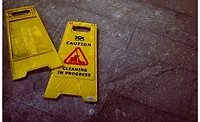COVID-19 Safety
The importance of a COVID-19 safety officer
NSF International develops training series for implementing a COVID-19 point person

Prior to the COVID-19 pandemic, businesses were already operating in what can be described as a VUCA environment—volatile, uncertain, chaotic and ambiguous. COVID-19 has magnified the level of uncertainty across nearly all business sectors, and especially those that are customer facing: airline, entertainment, retail, food, education, museums etc.
Many businesses have not survived the first wave of the pandemic and many more will very likely not survive the next wave of COVID-19 infection. The lockdowns experienced from March to June in many parts of the world were a drastic measure imposed to block the routes of COVID-19 transmission. Some countries were sufficiently disciplined to literally stamp out the spread of COVID-19. And, in general, due to the tough mitigation measures and public compliance with COVID-19 precautions, COVID-19 positive cases fell to low levels in most regions and hospitalization levels also dropped dramatically.
The summer was a period of respite from COVID-19 but the virus is renewing its attack and there is a sense of fatigue and perhaps in some cases a degree of resignation. As a result, many more people will get infected and become ill, and some will succumb to this virus. It does not have to be this way. New ways of working must be urgently adopted.
Winter is on our doorstep and we need to prepare for a long battle against COVID-19 while keeping businesses afloat and people safe. The imposition of lockdown measures may be required in areas experiencing high positivity rates and where health professionals predict hospitalizations will exceed capacity. However, there is a middle path where concerns over health and safety gain priority in concert with keeping businesses open. This middle path requires that every business take proactive measures to prevent the spread of COVID-19 and keep both their employees and customers as safe as possible.
As business take proactive steps and implement precautionary measures these measures must be visible to their customers. For instance, if a customer enters a car dealership and finds the environment to be chaotic with little regard for COVID-19 precautions, face masks barely present or dangling around the necks of salesmen, that customer will turn away, or worse interact with the employees of that dealership at the risk of contracting the virus. Picture the dealership next door that facilitates a safe interaction with its customers: all employees are wearing masks, the environment is not chaotic but subdued because fewer people are in the showroom and cars are wiped down between every test drive. In the second car dealership customers are made to feel safe from the moment they enter the dealership to the moment they exit, ideally in a new car!
An aspect of implementing visible precautionary measures is ensuring each business location appoints a person responsible for the implementation, maintenance and monitoring of the COVID-19 controls. This can be the existing Safety Officer on site if that role already exits, or it can be someone or a team assigned to develop and implement the COVID-19 response plan. The selection of this person is incredibly important due to the responsibility the position carries and the potential impact that person or team can have on the business.
The person and team selected must operate with confidence and with the support of company management. If they are already professionally trained in Safety Management or have a medical background it is likely they will step into the role with confidence and immediate credibility. If they do not have this background it is essential that they receive basic training in the fundamentals of COVID-19 infection risk and what is required to develop and implement a pandemic response plan. For this reason, NSF developed the COVID-19 Training Series—Pandemic Response Fundamentals. It is available for free and consists of three short modules which taken together provide foundational training:
- COVI9-19 Basics: Builds and strengthens foundational knowledge about COVID-19 to help understand the virus transmission mechanism and infection control measures.
- COVID-19 Response Planning: Focuses on response planning and it teaches how to identify risks and develop mitigation plans, together with initiating a pandemic response plan for organizations or verifying an existing plan is at the right level.
- COVID-19 Driving Culture Change: Focuses on how to drive culture change inside an organization, how to shift behaviors, and how to link the response plan to the communication plan of an organization in order to make the new ways of working stick and be effective.
A COVID-19 Safety Officer will need to ensure there is alignment across the organization, from top to bottom and across functions within the organization, ensuring no one is exempt from the key messages. This role will need to shepherd managers and supervisors in their responsibility to reinforce key messages to their teams to ensure the key messages cascade across the organization.
COVID-19 Safety Officers are encouraged to apply a systems approach in developing their company’s response and communication plan. This will ensure that it is a dynamic plan and not a static plan; as local and national guidelines change the response and communication plans must adjust accordingly. There will be a need to regularly connect with employees to gauge their acceptance level and raise any concerns. And as with any new system or protocol, a proactive internal verification system will provide additional input to update plans and fine tune implementation.
We have a long road ahead to widespread COVID-19 vaccine availability and immunization. During this period we can travel the middle road—avoid repeated lockdowns and keep most businesses open by taking proactive safety measures, leveraging the skills of employees, and ensuring fatigue and resignation are replaced by renewed energy and perseverance required to bridge the gap to when COVID-19 vaccines are widely available. The role of the COVID-19 safety officer will help organizations take visible proactive measures, based on the latest understanding of the virus and in compliance with state and local departments of health guidance.
James Morris has more than 25 years of pharmaceutical management experience in both plant operations and corporate offices, working with Pfizer, Cilag AG and Mass Biologics in the U.S. and Europe. He has held positions as Deputy Director QA/QC and Regulatory Affairs while at Mass Biologics, Director of QA/QC for the Biologics business unit of Cilag AG and several quality assurance and manufacturing roles with Pfizer, culminating as the head of Quality Assurance for Pfizer in Latina, Italy.
Looking for a reprint of this article?
From high-res PDFs to custom plaques, order your copy today!







